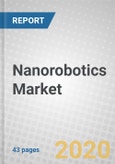The goal of this report is to cut through the hype and provide investors and others with a realistic assessment of the commercial potential of nanorobotics and its applications in various industries. This report focuses on the growing use of emerging technologies, such as most nanorobotics and their applications and how the market is expected to perform in the coming years. Specific objectives include identifying segments of the nanorobotics market with the greatest commercial potential between 2019 and 2025, projecting future demand in these segments, and evaluating the challenges that must be overcome for each segment to realize its potential to estimate the probability of successful commercialization.
The report includes:
- An overview of the global markets for nanorobotics technologies
- Analyses of the global market trends, with corresponding data analysis from 2019, estimates for 2020, and projections of compound annual growth rates (CAGRs) through 2025
- Highlights of the current and future market potential for nanorobotics along with a detailed analysis of the competitive environment, industry trends, drivers and opportunities
- Estimation of the market size and forecasted data for nanorobotics, and market share analysis on the basis of application, technology type and end user industry, with major regions and countries involved
- Company profiles of the market leading participants
Report Scope
The definition of nanorobots in the report excludes microbes whose metabolic processes are used to manufacture various biofuels, enzymes, specialty and industrial chemicals, and bioplastics, as well as in pollution mitigation and hazardous waste disposal. Nanorobots potentially include both electromechanical devices and biological mechanisms that mimic the functioning of electromechanical machines. Nanobots do not yet exist, but when they do, their potential applications include molecular manufacturing (nano factories) and medical nanobots that steer autonomously through the bloodstream, making repairs and guarding against infection. The term "nanorobots" is widely applied to such microbes, and studies that estimate the near-term market for nanorobots in the billions of dollars are generally defining such microbial factories or waste remediation microbes as nanorobots. From this report's point of view, the relevant distinction is that nanorobots perform a discrete action or task, such as delivering a cancer drug to a targeted tumor. Microbial factories or waste mitigation microbes accomplish their purposes utilizing continuous metabolic or other processes.
Table of Contents
Chapter 1: Introduction
- Overview
- Study Goals and Objectives
- Reasons for Doing This Study
- Scope of Report
- Methodology and Information Sources
- Geographic Breakdown
- Analyst's Credentials
Chapter 2: Summary and Highlights
Chapter 3: Market and Technology Background
- Nanorobotics Definition
- History of Nanorobotics
- Design of Nanorobots
- Operation of Nanorobots
- Navigation
- Power
- Locomotion
- Nanorobot Components
- Nanobearings and Nanogears
- Payload
- Micro-camera
- Electrodes
- Laser
- Ultrasonic Signal Generator
- Swimming Tail
- Nanocomputers
- Fabrication Approaches
- Top-Down Approach
- Bottom-Up Approach
- Hybrid Top-Down Bottom-Up Approach
- Bio-Hybrid Approach
- Nanorobotics Applications
- Market Trend Analysis
- Current Market Scenario of Nanorobots
- Analysis of Market Opportunities
- Analysis of Nanorobotics Market Applications in Various Fields
- Impact of COVID-19 on the Nanorobotics Market
Chapter 4: Market Breakdown by Type
- Overview
- Description
- Market
- Biological Nanorobots
- Nanoscale Nanomanipulators
- 3D Printing
- Biochip
- Other Nanorobot Types
Chapter 5: Market Breakdown by End User
- Nanorobotics Market Analysis by End User
- Healthcare
- Microelectronics and Information Technology
- Energy
- Environmental Protection
- Public Safety and Security
- Military
Chapter 6: Market Breakdown by Region
- Overview
- Nanorobotics Market Analysis, by Region
- North America
- Europe
- Asia-Pacific
- Rest of the World
Chapter 7: Company Profiles
- Bruker
- Gingko Bioworks
- Imina Technologies Sa
- Jeol Ltd.
- Kleindiek Nanotechnik Gmbh
- Klocke Nanotechnik
- Nanonics Imaging
- Oxford Instruments
- Park Systems
- Smaract
- Synthace
- Thermo Fisher Scientific
List of Tables
Summary Table : Global Market for Nanorobotics, by Manufacturing Type, Through 2025
Table 1 : Global Market for Nanorobotics, by Type, Through 2025
Table 2 : Nanomanipulator Suppliers and Developers, 2018
Table 3 : Global Market for Nanorobotics, by End User, Through 2025
Table 4 : Global Market for Nanorobotics, by Region, Through 2025
List of Figures
Summary Figure : Global Market for Nanorobotics, by Manufacturing Type, 2019-2025
Samples

LOADING...
Executive Summary
Nanorobots are nanoscale machines designed to perform a specific task automatically or under remote operator control at sub-micron dimensions. They refer to nanotechnology - an engineering discipline for designing and building nanorobots. These devices are made up of nanoscale or molecular components and range from 0.1-10 micrometers in size. Nanorobots are expected to have a variety of applications in the healthcare, military, automotive, and oil and gas industries. Continuous technological developments and growing R&D investment are therefore expected to drive growth in the global market for nanorobotics.
Companies Mentioned
- Bruker
- Gingko Bioworks
- Imina Technologies Sa
- Jeol Ltd.
- Kleindiek Nanotechnik Gmbh
- Klocke Nanotechnik
- Nanonics Imaging
- Oxford Instruments
- Park Systems
- Smaract
- Synthace
- Thermo Fisher Scientific







